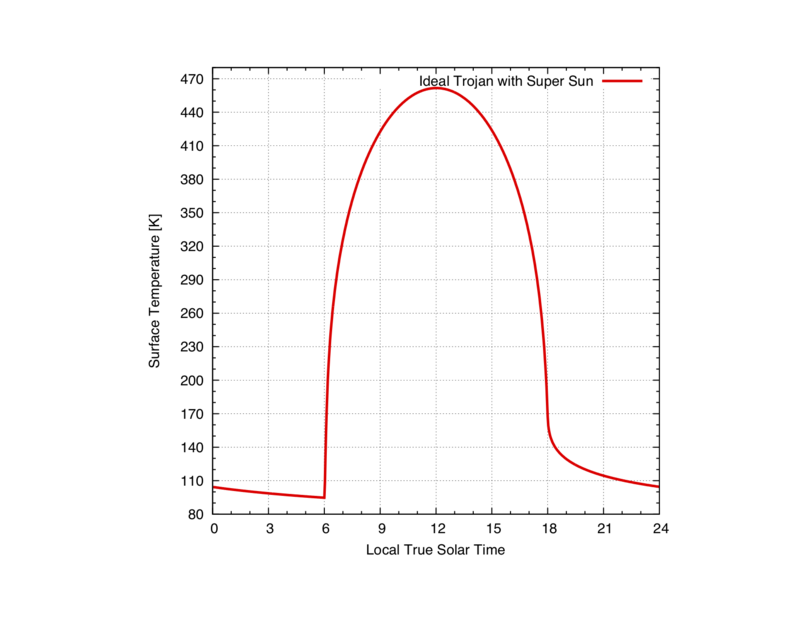KRC for Exoplanets
| Line 70: | Line 70: | ||
Then run exo_porb() with these arguments, for example: | Then run exo_porb() with these arguments, for example: | ||
| − | tmp = exo_porb(name="Exoplanet_0001",epoch=2451545.00,VisMag= | + | tmp = exo_porb(name="Exoplanet_0001",epoch=2451545.00,VisMag=0.,DisEarth=0.,e=0.5,a=1.2,rot_per=365.256,period=23.9345,Obliq=45.) |
To run KRC: | To run KRC: | ||
Revision as of 15:44, 26 May 2021
A user can define the orbital parameters of any body rotating around any star. PORB generates the rotation matrix accordingly.
Two approaches exist: one most suited for bodies where the orbital parameters are very precisely known, and one with more generic orbital parameters.
Option 1
Run PORB to create a structure that can be ingested to generate the orbital rotation matrix. The following arguments are needed:
- e: Eccentricity (Default=0)
- a: Semi-Major Axis in AU (Default=1)
- i: Inclination of mean orbit to ecliptic in degrees (Default=0)
- node: Longitude of the ascending node in degrees (Default=0)
- per: Argument of perihelion in degrees (Default=0)
- m: Mean Anomaly at epoch in degrees (Default=0)
- rot_per: sideral rotation period in hours (Default=23.9345)
- polera: Right Ascension of the pole in degrees (Default=0)
- merid: Prime meridian at epoch in degrees (Default=0)
- poledec: Declination of the pole in degrees (Default=0)
- period: Sideral orbital period in Earth days (Default=365.256)
- name: Body name (default ="None")
Then run generic_porb() with these arguments, for example:
tmp = generic_porb(e=0,a=1.,i=1.3,node=100.4,peri=293.9,m=79.6,rot_per=200.,polera=273.8,poledec=0.,merid=7.7, period=4332.5,name="IdealJupiterTrojan")
To run KRC:
OUT = krc(lat=0.,body=tmp)
Note: in this mode, the bodies are airless, unless otherwise specified by the user (set PTOTAL, DUSTA, ARC2_G0, TAU_RAT, TFROST, etc.).
Option 2
Run PORB to create a structure that can be ingested to generate the orbital rotation matrix. The following arguments are needed:
- name: Body name (default ="None")
- Vismag: Visual Magnitude of host star; used to derive a correction factor for SOLCON. 0 is recommended, and set SOLCON
- epoch: Time of periastron as full Julian date ; 2000 Jan 1 noon UTC= 2451545.0
- DisEarth: Distance from Earth to host star, in lightyears. 0 is recommended, and set SOLCON
- a: Semi-Major Axis in AU (Default=1)
- period: Sideral orbital period in Earth days (Default=365.256)
- e: Eccentricity (Default=0)
- Obliq: Obliquity of planet pole, in degree
- Lsperi: Season (Ls) at periastron, in degree
- rot_per: sideral rotation period in hours (Default=23.9345)
Then run exo_porb() with these arguments, for example:
tmp = exo_porb(name="Exoplanet_0001",epoch=2451545.00,VisMag=0.,DisEarth=0.,e=0.5,a=1.2,rot_per=365.256,period=23.9345,Obliq=45.)
To run KRC:
OUT = krc(lat=0.,body=tmp)
Note: in this mode, the user must provide PTOTAL, DUSTA, ARC2_G0, TAU_RAT, TFROST and GRAV.
These two cases above assumes the Sun as the central star. Any star can be defined by setting SOLCON (solar constant defined as the total stellar irradiance at 1AU in W/m^2. In the solar system, SOLCON ~ 1,361 W/m2.
out = krc(lat=0.,lon=0,INERTIA=20.,ALBEDO=.05,LKofT="F",body=tmp,SOLCON=2722.)
The case above assumes a start outputting twice as much energy as the Sun ("Super Sun").
Example of surface temperatures for airless body around a warm Sun.
